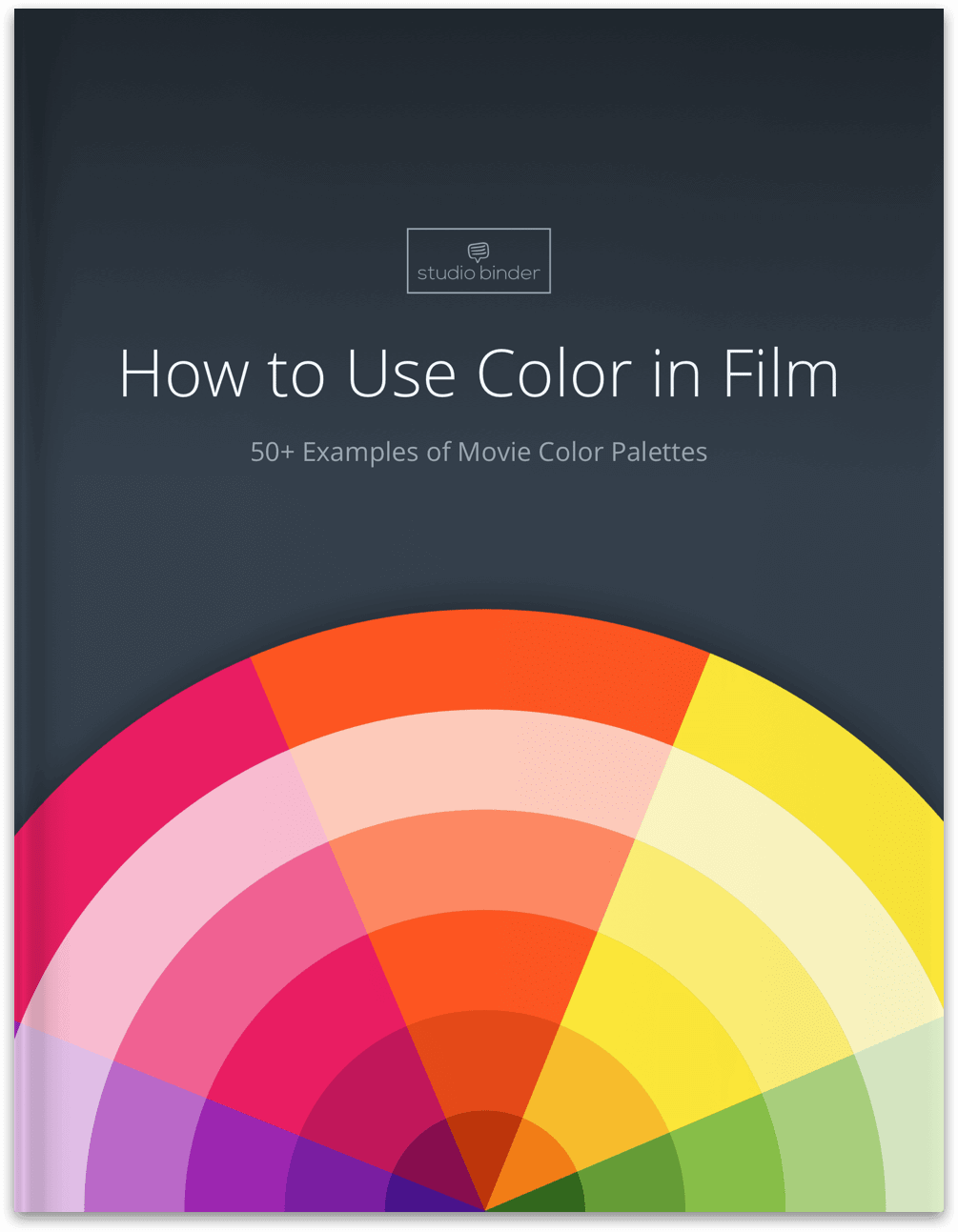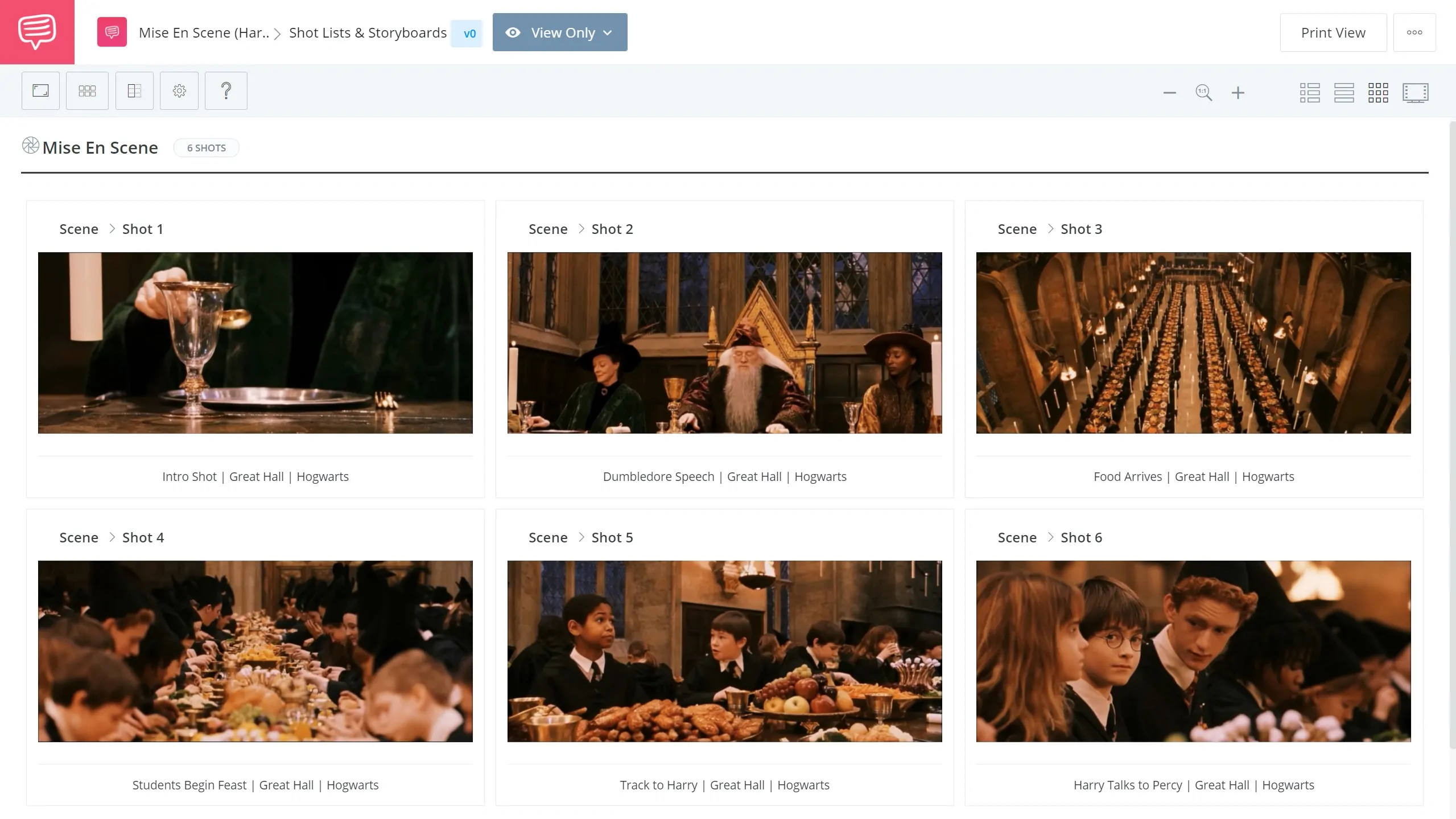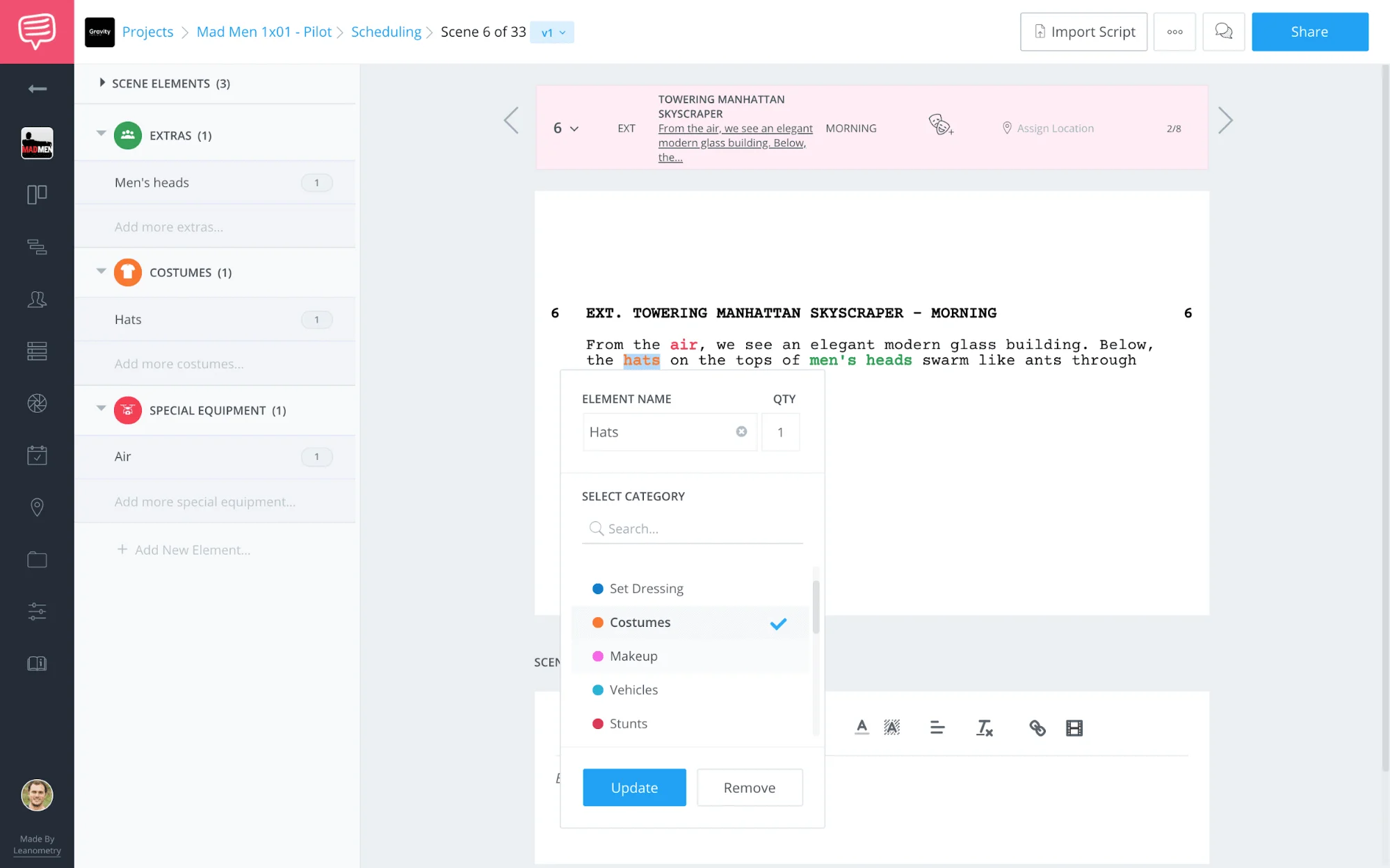Mise en scène can seem foreign, even to filmmakers, film critics, and movie buffs. Why is it important? How do you pronounce it? And what is mise en scène anyway. Grasping mise en scène is critical for anyone who makes or seriously watches any kind of visual content. For directors and producers, mise en scène in film and the script breakdown go hand in hand.
In this article, we’ll let you know what mise en scène is and how you can use it — both as a filmmaker and as a savvy viewer. We will define 20 key mise en scène elements and provide practical mise en scène examples. By the end of this piece you’ll be a mise en scène master, and you’ll know how to break down a script with greater insight.
Watch: What is Mise en scene?
mise en scène in film
Mise en scène definition
Mise en scène means everything that has to happen to make the finished image look the way it looks, which in turns helps your content feel the way you need.
Mise en scène refers to the visuals of a film.
It’s what we see onscreen — all the elements that appear on camera, how they are arranged, and the overall look and feel they combine to convey.
For the record, it’s pronounced meez-on-senn. Let move on to an essential question: How do you define mise en scène in film?
MISE EN SCENE DEFINITION
What is mise en scène?
Mise en scène is the arrangement of scenery and stage properties in a play. Translated from French, it means "setting the stage" but, in film analysis, the term mise en scene refers to everything in front of the camera, including the set design, lighting, and actors. Mise en scene in film is the overall effect of how it all comes together for the audience.
Mise en scene elements include:
- Sets
- Props
- Lighting
- Costumes
- Actor blocking
- Shot composition
Importantly, producers, directors, writers, along with sometimes hundreds of craftspeople, artists, and technicians all work in unison to present one picture. Mise en scène includes, quite simply, everything that goes into the production.
Everything in the frame. All that a viewer sees, hears, and feels. The total design of a film.
Consider Tim Burton's insanely creative filmmaking style and evocative production design. Each frame is bursting with style and personality, including his set, costume, and make-up designs.
Tim Burton Production Design • Subscribe on YouTube
Keeping track of it all can be daunting, but if you’re a director you can make it easy to divvy up and break down every element of your story, from props and wardrobe to talent and locations.
How is this done? By breaking down your script. Determining your budget. Tagging your elements.
Designing your production is a tall task. That’s why using an intuitive script breakdown and production management software makes it easier to manage. You’ll want to focus on details and logistics, but not lose sight of the art.
The big picture. That’s where a good breakdown comes in.
The mise en scène elements in this guide, combined with script breakdown tools, will empower you to better manage your filmmaking workflow. You’ll be able to track and control your project’s mise en scène throughout the process.
FILM TECHNIQUES
1. How location affects your scene
Here’s a veteran filmmaker tip: If you have a two-person dialogue scene and think any location will do the trick, think again. The difference between a conversation in McDonald's as opposed to a church can be extreme. Location says a lot about characters, intentions, obstacles, and themes.
What’s the difference if a conversation takes place in a synagogue or mosque? At Disneyland? What about in a schoolroom, a confessional … or how about in the trunk of a car?
Mise en scène in film • Out of Sight
When choosing a location, the budget often plays a role. Take a deeper dive into film budgeting during your script breakdown phase.
This will give you real-world parameters you can apply to every subsequent element of your mise en scène.
Start hammering out locations with your script breakdown.
MISE EN SCÈNE elements
2. Pick the right color
Filmmakers who think of color as something secondary, the exclusive domain of the production designer or post supervisor, do so at their own peril.
Color in film is a massive element of mise en scene that permeates every other visual element. The use of color is malleable and subjective.
Its role in creating mood or effect — indeed, its function in art of any kind — cannot be overestimated. Here's a look at Kubrick's use of color in mise en scene — notice how immediate and powerful his color choices are.
Kubrick's Color Palette • Subscribe on YouTube
Elements of film - cinematographer Roger Deakins and Cinesite work on color
Anyone who’s ever been to the south in the middle of summer knows that it is lush and green. Not especially dusty.
Color is a primary tool for filmmakers. You must appreciate its power. Especially in the post-technicolor film world, color not be considered an afterthought. It is a vital means of artistic expression.
What are the major elements of cinematic design? Color always comes at the top of the list. Need convincing? Consider Akira Kurosawa's color palette. For a complete guide to using color in film, download our E-book that covers color palettes and color schemes in cinema that have been used to great effect.
Cinematography techniques pdf
FREE Download
How to Use Color in Film
Hue, saturation, brightness — the three elements of color that make all the difference. In this book, we'll explain the aesthetic qualities and psychology effects of using color in your images. Topics include color schemes like analogous and triadic colors and how color palettes can tell stories of their own.
The more you know about color, the stronger your script breakdown will be and your mise en scene will follow suit.
Related Posts
MISE EN SCÈNE examples
3. Your set establishes your world
Mise en scène translation? It effectively means “staging.”
Since the earliest days of motion pictures, setting the stage has been crucial for creating worlds.
Something that can be as simple as a bench, like in Forrest Gump, or as grandiose as the fantasy settings of the Harry Potter film series, can do so much to establish the world and anchor the characters.
There is a reason most art departments are such a large part of any film budget.
Why? Half the battle of creating the world of the film can be won by giving attention to the set.
Check out the storyboard view of Harry Potter and the Sorcerer's Stone, in StudioBinder's Shot List feature.
If Harry Potter’s school of wizarding had been set in an American public school, it would be a very different film.
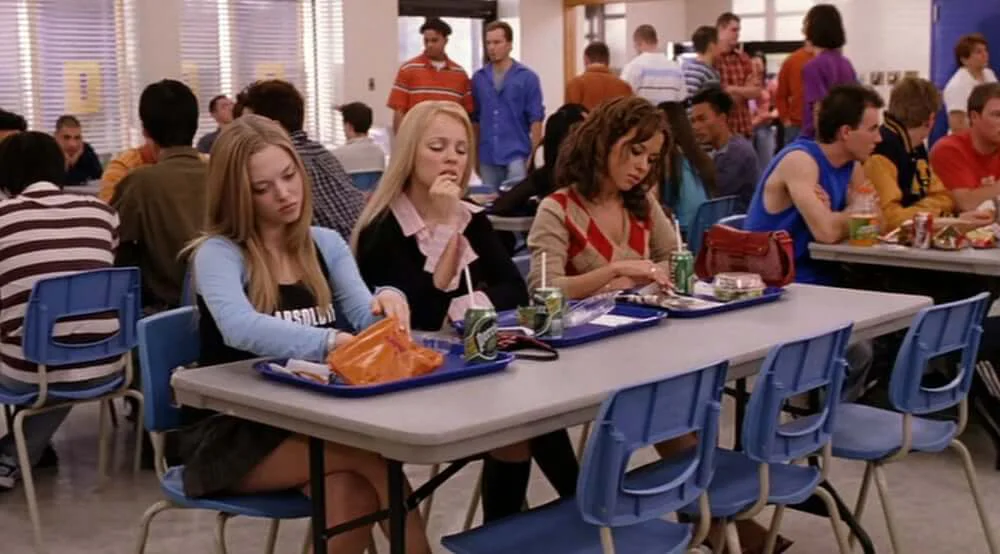
Mean girls wondering what’s up with the new wizard kid
Key mise en scène examples relating to set include the Harry Potter films and Titanic. In both cases, the set actively informs time, place, and story.
Tracking and managing set requirements early in your production process is integral to controlling your film’s mise en scène.
RELATED POSTS
MISE EN SCÈNE analysis
4. Props importance
The use of props as a component of mise en scène is often lumped in with set or wardrobe. This makes sense on a certain level, but props deserve separate consideration.
Whether a tiny item of large importance — think the Heart of the Ocean diamond in Titanic — or action-driving glittery articles like Dorothy’s ruby slippers in The Wizard of Oz, a prop (derived from the term “theatrical property”) may even be the focus of the entire film.
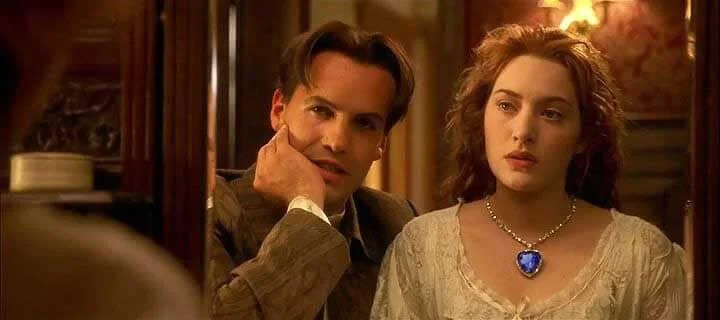
Mise en scene stealer? The blue diamond in Titanic
Imagine if Dorothy is being chased through Oz … for a pair of Jordans or penny loafers instead of her magical kicks. Different movie altogether, all because of props.
The objects in your frame are interacting with every other element of your mise en scene all the time. Whether the filmmaker recognizes this or not, the audience sure does.
Even if a character is not directly lifting, donning, tripping over, or smashing a prop — if it’s in frame, it’s part of your story.
Let’s look at an example: Creed.
We’ll spend some time in Adrian’s restaurant with Rocky and Adonis. We’ll identify and tag all the elements for each department for your script breakdown.
Mise en scene elements in Creed • Subscribe on YouTube
Props have power. They’re vital elements of film. Any mise en scene definition must include them. Any script breakdown must tag them.
RELATED POSTS
wear MISE EN SCÈNE on your sleeve
5. Costumes make the difference
The costume, or wardrobe, is another key part of the filmmaking arsenal when composing mise en scène.
What characters wear says much about the world they inhabit, who they are within the world, how they feel, and how they carry themselves.
Keeping track of wardrobe can be a tricky task from the outset. Breakdown your script with robust software that makes your film’s costumes easier to track. You can use StudioBinder's script breakdown feature to do it.
Script Breakdown Software • Subscribe on YouTube
With the intuitive drag and drop menu, highlight the particular wardrobe piece, you need, and simply tag it as "costumes."
Furthermore, costumes bring together every other part of the mise en scène. The costume grounds the character in the world created.
Look at any film and you’ll see proof that costumes are one of the most important elements of mise en scene. Costume gives the audience unmissable information about each character.
In Gone with the Wind, wardrobe contributes to our understanding of the story’s time period, social structure, action, and scene composition. It also defines (or belies) characters in straightforward, instantly felt ways.
The clothes in The Breakfast Club serve as key elements of film. Wardrobe in the story conveys a variety of universal high school archetypes while also managing to provide each character with his or her own unique personality.
Costumes tell us a lot about both the big picture and the particulars.
why is MISE EN SCÈNE important?
6. Hair and Makeup
Costumes extend and bind all the elements of mise en scène. This is also true of hair and makeup, with intimate connection to talent.
Alice In Wonderland, Marie Antoinette, and The Lord Of The Rings Trilogy showcase hair and makeup’s significance in creating character.
By magnifying and externalizing character traits, hair and makeup contributes to the elements of film in even the most complex worlds.
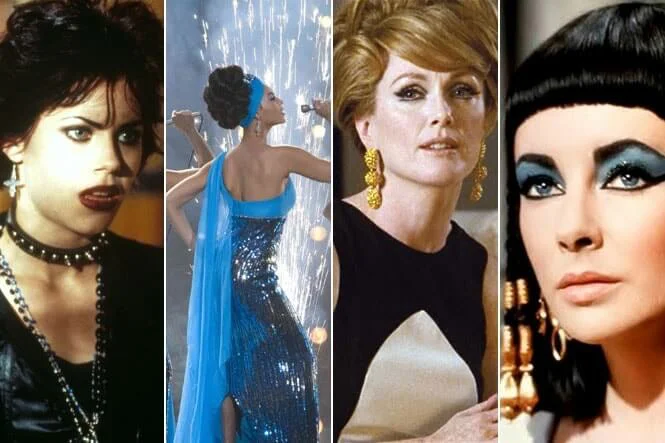
Alright, mise en scene, I’m ready for my close up.
Hair and makeup can revitalize familiar characters, dispel preconceived notions about them, and make them relevant right now. Such is the case with the Joker in The Dark Knight Trilogy.
When it was announced that the character of the Joker would be rebooted in the new Batman series, many scoffed at the idea of recreating a character that Jack Nicholson had made so iconic for Tim Burton.
A similar adjustment was made for Todd Phillips' Joker as well. Here's a breakdown of how that character was realized in each iteration.
How Costume Changes Character • Subscribe on YouTube
With a radically different approach to the character’s hair and makeup, the new iteration of the Joker dispelled memories of the original and helped win Heath Ledger an Oscar.
RELATED POSTS
MISE EN SCÈNE spotlight
7. Lighting sets the tone
Film techniques seen and unseen contribute to your mise en scène. Lighting techniques exemplify this “seen and unseen” quality. Just ask a cinematographer.
Lighting is one of the key elements of film. It’s the pièce de résistance in completing your mise en scène. Here's one of today's premiere DPs, Roger Deakins, discussing his relationship and approach to lighting.
Lighting is one of the essential mise en scene elements • Subscribe on YouTube
Lighting, like all the elements of mise en scène explored on this list, is best considered early in Pre-Production, during the script breakdown phase.
We find a striking example of lighting the Film Noir genre. The Film Noir style characteristically has strong contrast in color or shade with a prevalence of chiaroscuro lighting. This isn’t only because a lot of classic Film Noir movies are shot in black and white: it’s also achieved through lighting.
A good use of these film lighting techniques in a film outside the Film Noir genre is found in Schindler’s List.
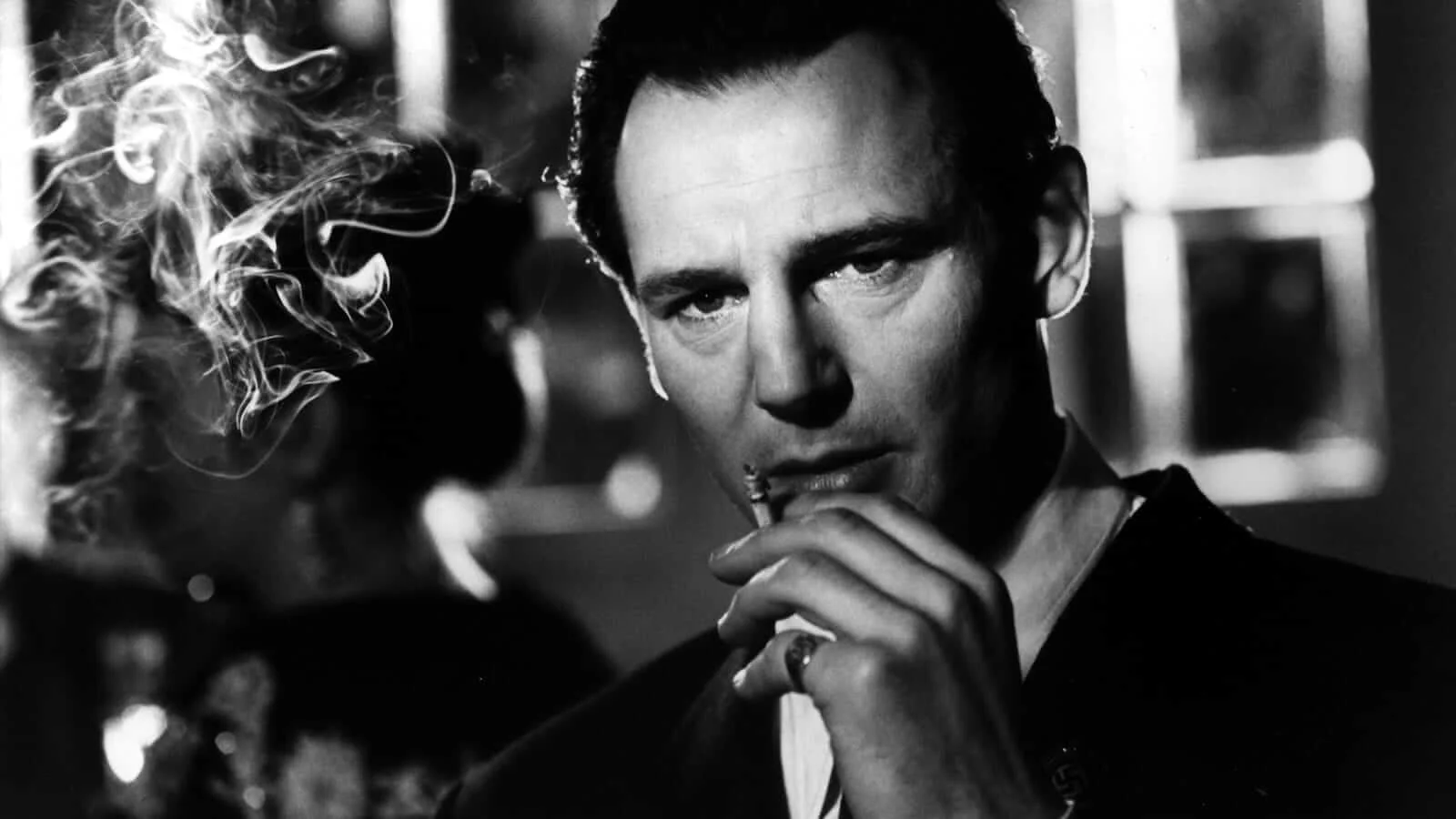
The contrast of stark blacks to ethereal whites, the moody lighting, the highlights seen and unseen all combine. They inform us of the theme of this period piece and the characters’ places in the world.
But a film does not have to use drastic lighting to set mood, tone, or theme.
RELATED POSTS
MISE EN SCÈNE
8. The medium — film vs. video
You’re making a film, right? Film is the material that records moving images. It’s also the movie you make with those moving images.
Different kinds of film and processing techniques lead to different kinds of mise en scene. And between film, chemicals, digital, software, apps, and other tools, the possibilities are vast.
FILM DEFINITION
WHAT IS FILM?
Film is a thin plastic strip coated with light-sensitive cellulose for exposure in a camera, used to produce moving pictures.
The size and uses of film vary. A film strip can be as small as 8mm and as large as 70mm. Film can be processed with chemicals such as tungsten to achieve a variety of effects.
This simple definition spawned an entire universe of artistic expression.
The variety of film that has been generated by Kodak or Fuji, to name only a couple, is truly astounding. It is hard to believe that there was once only one kind of black and white film.
That’s right, once upon a time filmmakers had a small selection of black and white film available. Today, the choices are abundant, beginning with size: 8mm, 16mm, Super 16mm, 35mm, 65mm and so on.
Then there is black and white or color, as well as stock and speed. Choosing a film stock is important for creating the look of your scene. One more obvious thing about film. It no longer has to be film. It can, and more than likely will be, digital.
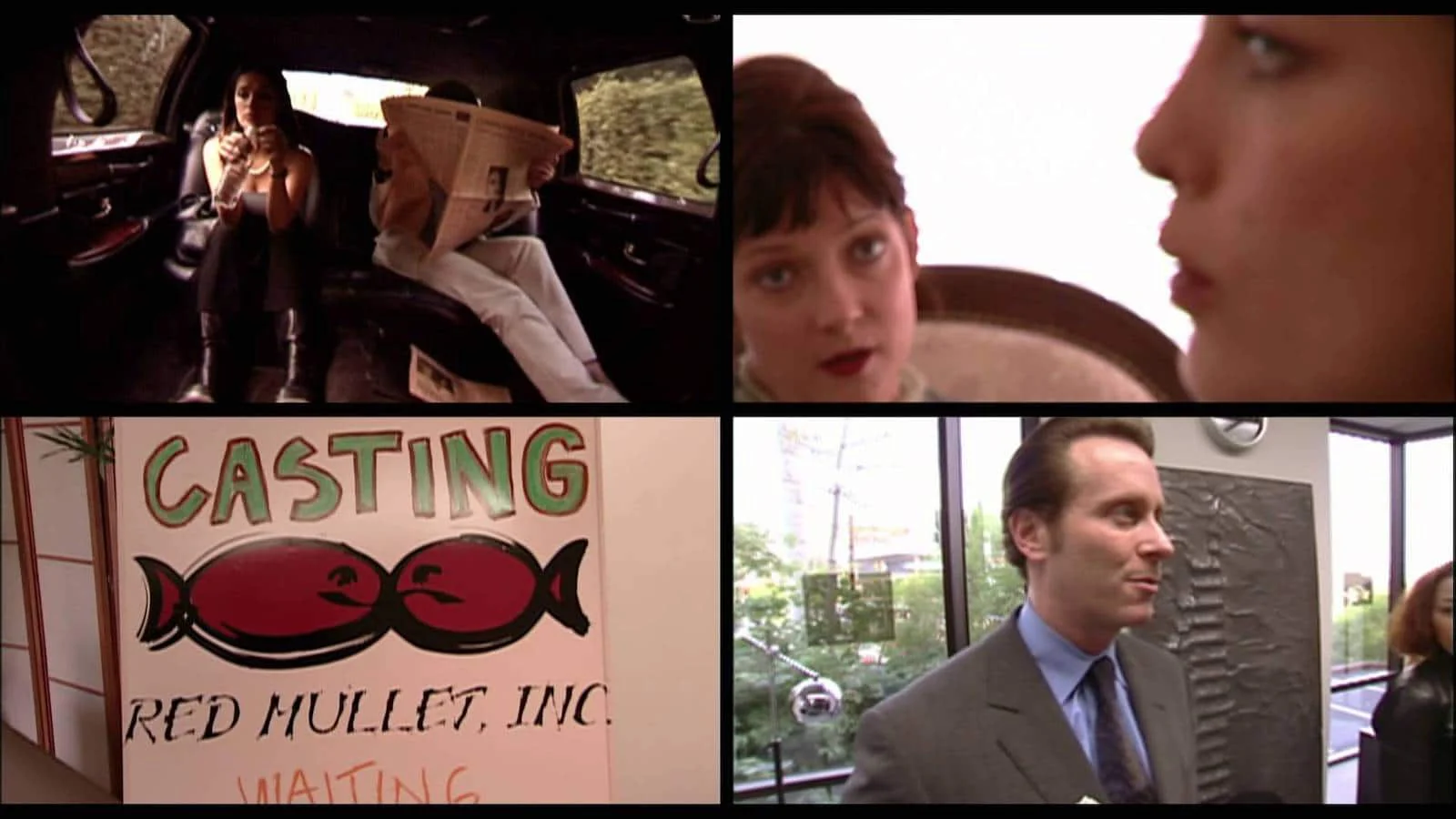
Mise en scene in video: the film Timecode was shot on four camcorders
Film or digital is now the ultimate question when it comes to making a choice for your project’s mise en scene. Check out test footage for the best 4K video cameras. Talk to other filmmakers. Do your research.
Which leads us to the next section.
elements of film
9. Picking the camera
Your camera does more than simply record your mise en scène. It actively shapes it. If the mise en scene translation comes out to “staging” or “putting on stage,” then what kind of camera you use makes a difference.
Your choice of camera is an essential element of mise en scène. It can paint as distinct and unique a picture as any other element.
At the heart of filmmaking is manipulating and capturing light to produce a picture. What you use to capture that light, simple or advanced, has an effect.
For instance, filmmaker John Cassavetes hated the artifice that was so common in the early years of filmmaking. He leaned towards improvisation in performance and Cinéma Vérité as a rule for mise en scène.
CINEMA VERITE DEFINITION
WHAT IS CINEMA VERITE?
Cinéma vérité is a genre and style of filmmaking characterized by realism in all aspects of mise en scène. Using simple equipment and often improvised story and structure, the style lends itself to independent filmmaking. It has given rise to subsequent film movements such as Dogme 95.Cassavetes grabbed the nearest Bolex 16mm camera he could find and hit the streets to make his masterpiece. Paul Thomas Anderson did almost the polar opposite in his film The Master.
He used a 65mm camera that insured that the subjects in his frame would be seen in a much higher resolution, as part of a literally wider world.
But one need not use a 65mm camera to achieve these effects.
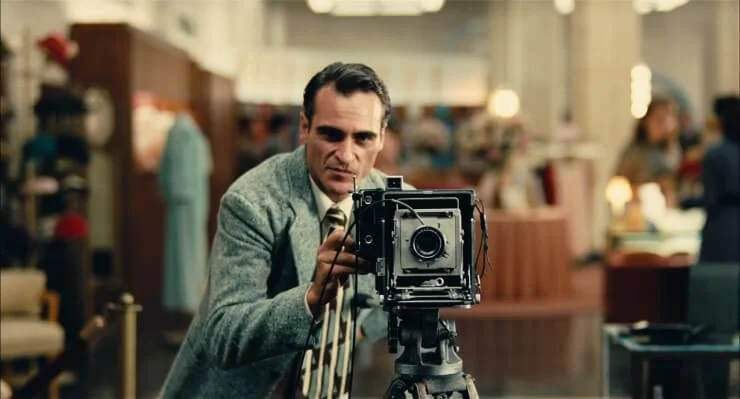
Panavision 65mm - it’s as if 4k and 16mm had a mise en scene love child
The scope of the film and whether or not it is digital plays a large role here. There are now digital versions of 16mm, Super 16mm, and so on.
Every cinematographer can consider a wide array of camera choices to benefit your particular story.
RELATED POSTS
MISE EN SCÈNE in motion
10. Camera placement
Where you choose to put your camera is just as important as what kind of camera you use. No viewer will be thinking of where you put camera if you place it correctly. Here we cannot overstate the importance of a shot list.
Camera Angles Explained • Subscribe on YouTube
Whether at a high angle above the subject or a hundred feet away, where the camera is and what it captures should be determined before you arrive on set.
Make a shot list. Start tagging your elements. Stay organized. Be prepared.
You’ll make a better film.
RELATED POSTS
speed of MISE EN SCÈNE
11. Speeding up or slowing down film
As a filmmaker, you can shape and bend your created world like a wizard. Time can stand still, it can move at a fraction of normal speed or be sped up into a blur. This all comes down to frame rate. Here's our guide to frame rate and the options filmmakers have to manipulate their mise en scene.
Ultimate Guide to Frame Rate • Subscribe on YouTube
You can also change the tempo of your world and your characters with fast or slow motion. You, as a filmmaker, are a master of time and space, all contributing to mise en scene.
Many filmmakers have used the speed of the scene to accentuate every element of mise en scène. Whether fast motion or slow motion, you can become a master of time and space by controlling your elements of film.
Chariots of Fire, Raging Bull, Any Given Sunday and pretty much every other sports movie ever offered from Hollywood would not be complete without a slow-motion finish for the victor.
The speed of the scene is an easily accomplished film technique that is a cornerstone of filmmaking.
MISE EN SCÈNE on the scene
12. Comprehending composition
Composition is an element of mise en scène that has infinite possibilities. There are rules of composition many image-makers use when framing their subjects. These can be obeyed or broken depending on your intent for the shot but how you frame your shot is massively important in bring all of these mise en scene elements together.
Ultimately, characters and action should suggest the layout of the image, the placement of elements within it. Good composition guides a viewer’s eye and leads a viewer’s focus within the frame.
The Rule of Thirds is one way filmmakers can imbue their frame and scene with the focus they desire.
Mise en scene elements • The Rule of Thirds
Unless it reads a certain way in the script, where everything is placed does allow for creative liberties. But be careful that something you place flippantly will not lend itself to an unintended, confusing, or ulterior meaning.
You’ll really want your composition and placement to be intentional.
RELATED POSTS
film techniques on display
13. Form and Frame
Bring it all together.
If you’ve done everything else right, you won’t want to leave these “unseeable” aspects of mise en scène to chance. Every beautiful picture deserves a spectacular form and a well-thought-out frame.
The form is the twin of composition. It’s not the who, what, where, or when.
Form is the how. How is your mise en scene communicated?
Animation? Puppets? Stop motion? Live action? A combination? How are the elements woven together in a symbiotic relationship?
Wes Anderson is a fan stop motion, miniatures, and live action. These forms set the tone for the entire mise en scène in films like Isle of Dogs.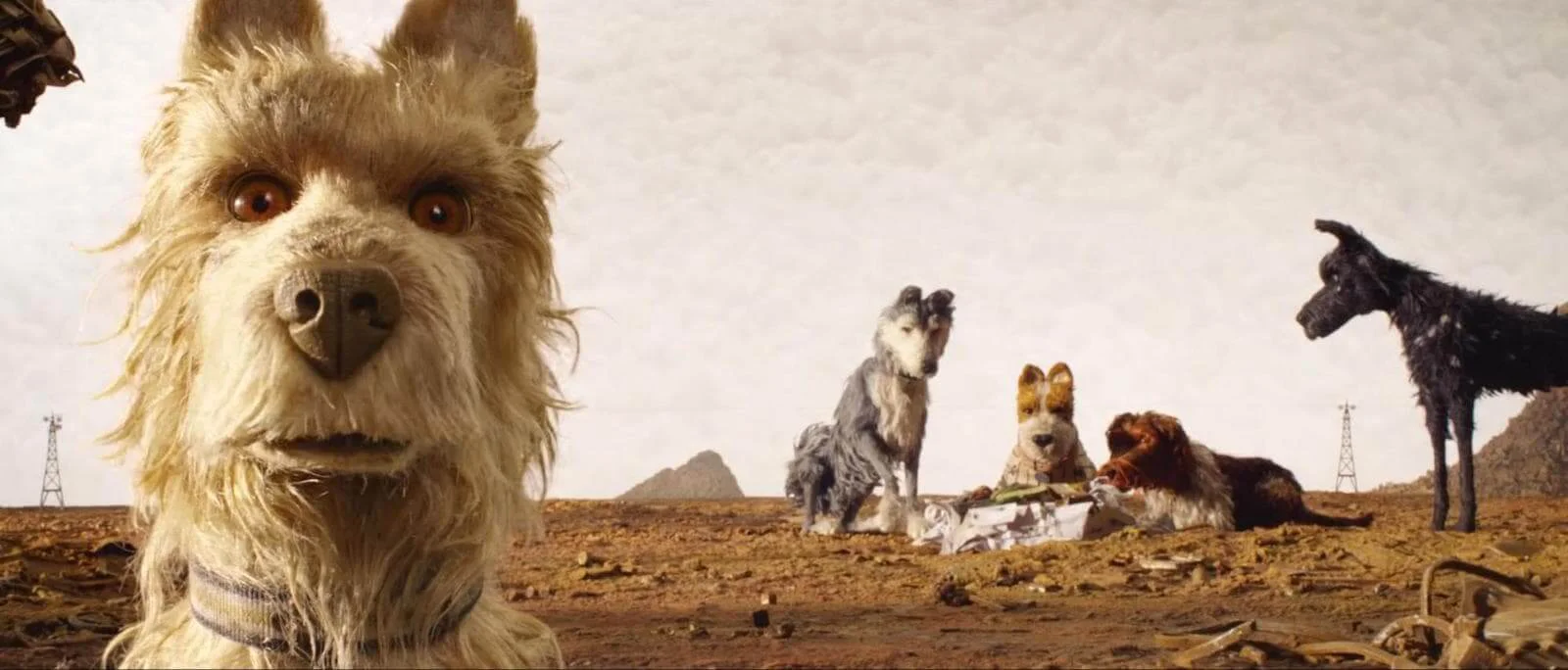
Form and frame: elements of film in Isle of Dogs.
Now for frame. Your picture’s almost done. How do you want to frame it? An example of how framing makes the scene in The Shawshank Redemption.
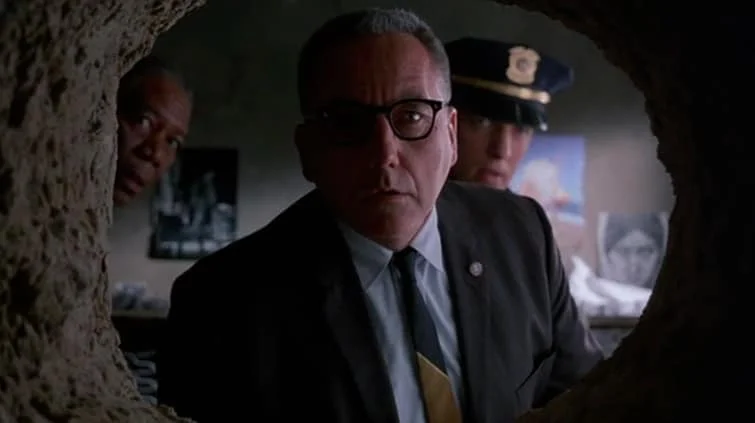
Framing and mise en scene elements in The Shawshank Redemption
To say that the framing in the scene of the discovery of the escape is masterful is no hyperbole. Here, the warden is literally framed by the tunnel that will be his undoing.
Framing takes composition to the next level. When you frame your film, you’re doing so with the understanding that your created world functions within the real world. Where will you set the parameters for your viewers?
Camera Framing • Subscribe on YouTube
You’re deciding where the form of your story ends and the real world begins. You’re putting a border around your film — or artistically suggesting that the border doesn’t exist at all.
Frame is as crucial as any of the other mise en scene elements on our list.
focus on MISE EN SCÈNE
14. Depth of Field
Depth of field is one of the subtler elements of film, but a measurable one. How you use it contributes meaningfully to your work’s mise en scène. We've seen other mise en scene elements designed to draw the audience's attention. And using the camera is yet another tool to achieve the same effect, oftentimes in combination with other elements such as color or lighting.
With a light touch, a filmmaker can play with peripheral elements while keeping the primary focus in the viewer’s sights. Here's our ultimate guide to camera focus and how filmmakers can use techniques like deep depth of field, shallow depth of field, and the rack focus.
Mise en scene elements & camera focus • Subscribe on YouTube
Ask yourself, what draws attention first, then second, and even third? What’s the order of importance to what’s being shown, and why?
One of the most effective film techniques to master focus: depth of field.
RELATED POSTS
listen to your MISE EN SCÈNE
15. Sound design
Sound design is one of the elements of film that often gets neglected by fledgling filmmakers.
Rest assured, effective use of audio is the single easiest way to heighten a lackluster scene — or ruin a great one.
Whether you are using diegetic or non-diegetic sound, music, and sound effects, it is critical that you think of what is heard as essential to your mise en scene elements.
In this video, we examine how Quentin Tarantino uses sound to modulate the tone of his violence. When he wants a scene to be disturbing or when he wants it to be fun, sound design plays a major role.
Tarantino's Sounds of Violence • Subscribe on YouTube
Sound is so high on the list of film techniques that it has not one, but two Academy Award categories. Here are our favorite Best Sound Editing and Best Sound Mixing winners.
Think hard about how you use sound, and don’t let it fall by the wayside in your creative project. No mise en scene definition would be complete without sound.
MISE EN SCÈNE rhythm
16. Music
The importance of music in film cannot be overstated when it comes to completing your mise en scène.
Ask anyone what comes to mind when they think of movie music, and odds are you’ll hear mention of Star Wars and Indiana Jones, maybe Jaws and the James Bond theme.
And what about films like American Graffiti, Dazed and Confused, and Pulp Fiction? Their well-curated popular songs infuse and reflect every single one of the other mise en scene elements.
Not to mention films with music, and musicians, at their core: Straight Outta Compton, Amadeus, Bohemian Rhapsody, What’s Love Got to Do with It.
The list goes on. And then there’s musicals! What do these films and their music have in common?
The music becomes a character in the film itself. The leitmotif and the character are synonymous.
The rhythm, tempo, and texture of mise en scene is tied to the music.
When we think of “The Raiders March” (“Indiana Jones Theme”) we can’t help but envision Harrison Ford in character as Indiana Jones, wearing his hat and running from a boulder, or wielding his whip and leaping off a cliff.
Music, or the lack thereof, can be effective in painting a full picture. Music also is a way for the filmmaker to communicate to the audience. The filmmaker can inform and enrich the what, when, why, and how of a story’s moment-by-moment emotional resonance.
essential film techniques
17. Know the talent
Your actors are one of the most essential mise en scène elements.
Many directors feel that if you cast correctly, that is to say appropriately for the characters, story, and overall vision, then half the battle is already won.
Actors’ strengths and weaknesses can be exploited when they are the central focus of a scene.
Some actors are chosen for the melodramatic or overacting quality of their performance. Think Jim Carrey in 80 percent of the roles he’s played.
Jim Carrey literally chews the mise en scene.
Jim Carrey would be out of place in a Merchant Ivory film. The term “chew the scenery” can be used as a positive or a negative, depending on the scene and the intention.
The look and ability of your actors articulates your film’s mise en scene definition. For directors, working with cast on performance is quite possibly the most dominant way to shape mise en scene.
block by block
18. Blocking actors
Just as camera placement and movement are essential, so are placement and movement of talent.
Blocking takes all the mise en scene elements directly to the cast.
Attack the block - blocking mise en scene examples
Where an actor is arranged, and if, when, and how an actor moves in the scene, all highlight the reason for the scene itself.
Blocking organizes the action, the business of the moment. It flavors what’s going on, both on the surface and underneath.
Does an actor take a step, scratch an itch, put on a hat, do a jumping jack, bite into a sandwich? Does an actor do this before, after, or in the middle of speaking? Why? It can all have a major effect on the dynamics of the scene.
Blocking and Staging • Subscribe on YouTube
Consider what your actors do and how the action reads to your audience. Put yourself in the theater — how would you interpret it?
The term “What’s my motivation?” was coined by an actor given blocking direction that had nothing to do with the scene they were in.
Be prepared to explain and justify your blocking choices to collaborators, especially to your on-screen talent.
Your mise en scene depends on it.
elements of film in motion
19. Action in the background
The main action in any given moment is what your mise en scene all comes down to. What’s the conflict, the desire, the intention? How does it unfold? Where do your characters start in a scene, and where do they end?
Not just physically, but emotionally. How do they change?
Background action, seemingly throwaway action, and any action that is secondary to that in primary focus can be memorable and valuable as part of your mise en scène.
In Midsommar, director Ari Aster uses the wide open spaces of his daylight rural setting to create an extra layer of foreshadowing and suspense.
Mise en scene in action • Midsommar's background
This is a specific use of action in the background to complete the story. Remember that lack of action is still a form of action.
Even if characters do nothing, inaction becomes their action. Mise en scene depends on what’s being done.
MISE EN SCÈNE in film
20. Post-Production
The final step to completing your mise en scène is often the final step in locking your film.
Post-production and/or, more specifically, CGI or Computer Generated Imagery, can be the icing on the cake for your completed film.
You want to minimize surprises in executing your mise en scène by starting with a solid script breakdown during pre-production.
The script breakdown phase is also where you’ll want to determine what you’ll aim to accomplish during the post-production step. Unforeseen fixes and tweaks will very likely arise, and post is an ideal place to address these — but you’ll want to keep “major repairs” to a minimum.
The rapid growth of CGI can create mega-worlds of wizards and superheroes. This translates to the ability of filmmakers to add many critical mise en scène elements with computers.
up Next
Wes Anderson’s Mise en Scène
Mise en scène elements can be as simple as an actor in front of a camera. It can be as elaborate as a thousand-person crew and twelve visual effects teams. Wes Anderson has mastered all the mise en scène elements and crafted his own style. Find out how right now.
UP NEXT: Wes Anderson’s Mise en Scène →
Easily create script breakdown sheets online.
Import scripts. Tag elements like props, wardrobe, and cast. Create breakdown summaries and DOOD reports in a snap.
